The last time I wrote a full review of a Dawn of War game I started throwing around terms like “a prima facie truth”. Admittedly I was trying to be ironic – it was about how fun it is to smash big mechs into each other! – but also admittedly, there is something about this series that just makes me get a bit over-excited. The original Dawn of War, which took your little villagers in from the cold and turned resource generation into a game of take-and-hold, is a legendary part of the grand RTS tapestry – and it’s also a personal, formative game of mine.
That makes it all the more baffling that, somehow, a good 20 years on, we’ve never actually had a classic, straight-ahead sequel to it. DoW 2 took things in a tighter, more tactical direction, which was perfectly good in its own right but offered little in the way of satisfaction for RTS-heads. DoW 3 was famously controversial, as Relic took a big, ambitious swing at mixing real-time strategy with a bit of light MOBA gubbins and got duly punished for it (I stand by my belief that it was good of them to try something new there; I also very much would’ve liked a good old RTS to go with all the stellar work that studio did with those massive Titan animations and visual effects.)
Which brings us to DoW 4, announced at gamescom’s Opening Night Live, which somehow feels both incredibly surprising and inevitable at once. Surprising in that, after the third, it felt like this series would be on ice for a while – especially as Relic, who you might’ve expected to still get a stab at the fourth, naturally had to fall back and regroup a little after buying its independence from Sega. And inevitable in that this is the way not just games but all of pop culture seems to go these days, eventually. You get the original, a classic, that aims straight and true at a clear idea and nails it first try. Then you get all kinds of sequels, reboots, gritty remakes and the rest, as the trends of the day inevitably prove too hard to resist. And then, when everyone’s suitably pissed off: the triumphant return, touting a revival of all things that made the original great (with mixed success).
Anyway, Dawn of War 4 does that and, let me tell you, this feels anything but rote. I’ve played one mission of it, but reader I’ve played that one mission about half a dozen times already because it’s brilliant. Picture the sequel to the original Dawn of War that you’d make if you could. Is it a classic, base-building, large-army-managing RTS? Yes. Is it grim and dark and full of wonderfully excessive gore? Yes. Does it still have those extra-large special units? Does it have customisable skirmishes, co-op, old school online multiplayer, and an army painter? Some very flashy visual effects? Some big ol’ guns that sound like thunder? Does it have Gorgutz? Crucially: yes.
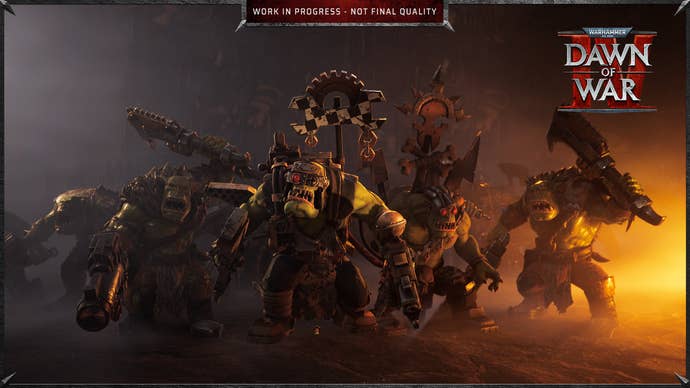
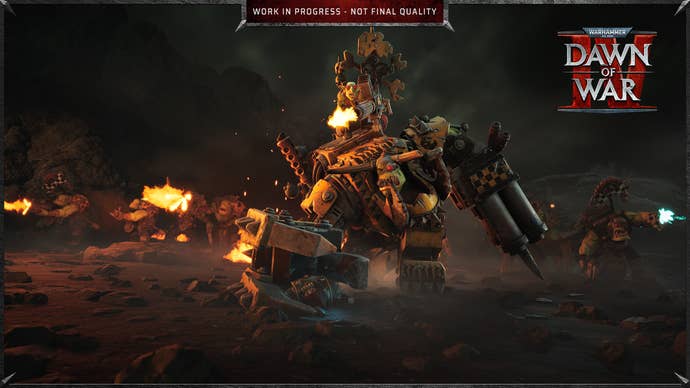
As Dawn of War 4’s developers explained to me in our interview – which you can look out for here on Eurogamer very soon – naturally that’s been much more complex to put into action than it reads here on paper. But from that single mission I’ve played, the early impression for me is that their work is shaping up to be a resounding success. Dawn of War 4 feels like true Dawn of War, as hard as that may be to define.
The mission I played was a skirmish, albeit one with a bit of a narrative arc to it. The Imperial Guard – not a playable faction here but, interestingly, a pretty fleshed-out one controlled by the CPU nonetheless – needed help defeating some Orks, as they always do, and in come us Space Marines to the rescue, in the form of the returning Blood Ravens and– splat. Drop pods are in, and they do some lovely giblet-generating damage to enemies, also coming with a tasty mounted gun to act as a kind of minor defensive turret after landing.
A notable tweak from the original Dawn of War that feels deliberately highlighted in this little intro: Space Marines are properly durable compared to their Ork and Imp counterparts. Two basic squads and your commander unit, Cyrus, dispatch about six squads of low-level Orks. Also notable right off the bat is the amount of upgrades and active abilities at your disposal. This isn’t DoW 3 levels of active, don’t worry – more like a version of DoW 1 where your grenades and the like are just a little more readily accessible. Cyrus is slightly different there, in having a kind of miniature skill tree for you to pick two or three upgrades from – a remote-detonation bomb is incredibly powerful, or you could build him as a kind of invisible sniper or passive buffer, who can cloak his attached squad too.
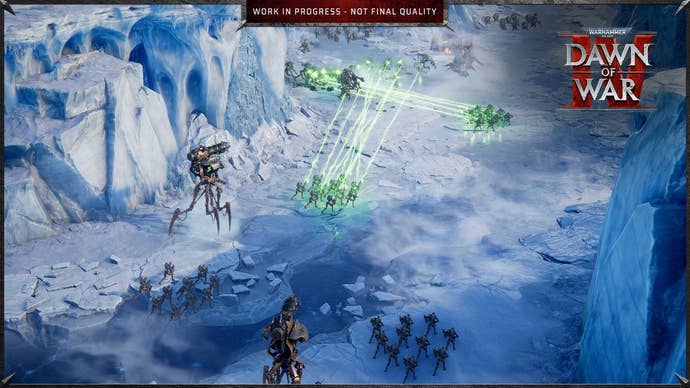
At the squad level, this feels like a mix of the first DoW and another Relic gem, in Company of Heroes. Units now have a retreat function that, like CoH, sees them sprinting back to base, which goes alongside the reinforce button (there’s also built-in healing on your vehicles via the equivalent button – the Space Marines have no builder units at all. Buildings themselves are constructed from a button on the universal menu at the bottom of your screen.) For the Marines this feels like a pretty essential function: their whole thing is that they’re more powerful but more expensive, and so closely watching them, ensuring you lose as few individual men as possible and definitely as few full units, becomes essential to higher-level play.
After setting up a base nearby it’s time for some classic DoW-ing: heading out to clear out enemy defenses and forward bases, claiming requisition points – static capturable zones on the map that give you one of two key resources – and likewise power nodes. That’s a second minor tweak to the formula: power now comes from power-specific points you capture just like requisition ones, rather than generators you can build at your base. Another nod to Company of Heroes there – with power being key for vehicles and late-game units, it’s basically like the split between CoH’s manpower and fuel.
Other resources will come into play depending on your faction. The Orks have Waaagh, as ever. The Space Marines have one earned from basically doing things well that goes towards stratagems – hugely powerful abilities like the classic Orbital Bombardment, say, which is wonderfully satisfying but to my mind also felt almost a touch overpowered here, or one that gives your units a burst of XP. (Space Marines also have XP now! Highly levelled-up units, another CoH nod to veterancy, is another smart factor in making them more powerful – but also more important to keep alive, often at great expense.) The Necrons meanwhile focus around a power matrix, which they spread to grant their units buffs, and the Adeptus Mechanicus use something called “cogitator relays” to strengthen a kind of network of their own – we didn’t see much of them here.
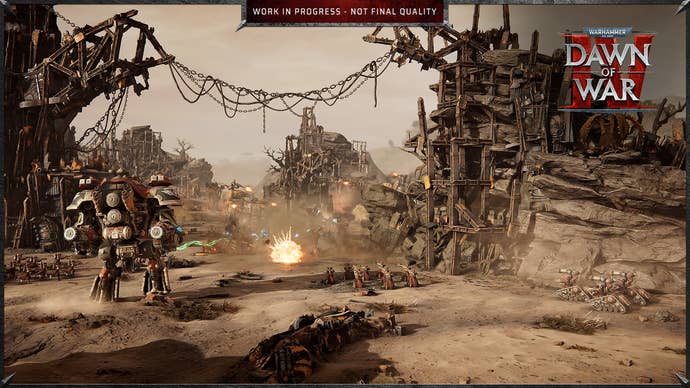
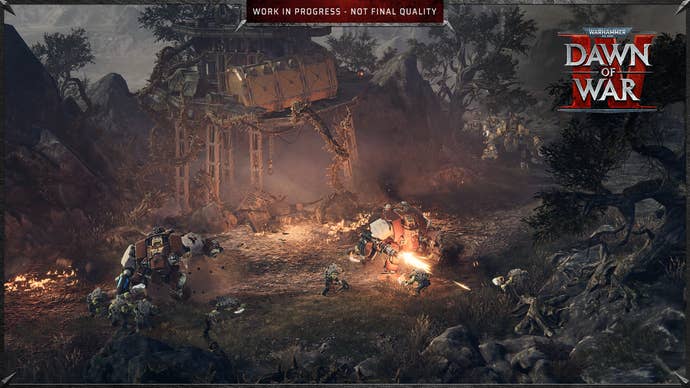
It’s worth focusing a tad more on the promised differences in playstyles here. While I only played as the good old Space Marines, KING Art promises the Orks will focus more on cheap, mass-scale units and buildings and spreading out rapidly across the map, as you’d expect. The Adeptus Mechanicus have bonuses like being able to see enemy movement on the minimap through fog of war, and that network-based buff. Minor spoilers for this random skirmish but, at one point they rock up with a Knight Castellan walker too, to face off against a (surprise!) Necron Monolith incursion, showing off those two factions’ largest “super heavy” units in a very tasty little face-off.
Back to the Marines and the rest of the mission. After clearing out a forward base of the Orks as a minor objective, it’s revealed they’re building three Gorkonauts at three separate points on the map. And so off you go to destroy them before they get build (I left one to completion on one playthrough just for a twist, which was fun, though also something immediately dispatched by that Orbital Bombardment – I have a suspicion this’ll be harder to earn and use in a regular playthrough compared to this demo, which seems designed to show off everything KING Art possibly can in one mission.)
After that, it’s time for that very fun diversion of the Necrons popping up, an unsettling cameo from some unknown Adeptus Mechanicus character here to do some “scans”, a bit of a tussle and then a push on to the Ork base. Immediately evident amongst all this, though, is the map design, which feels like a nice modernisation of classic DoW again. It’s smartly asymmetrical, with the Orks having faster routes to the flanks and the protection of solid landscape centrally, but then you, from the South, having easier control of the heart of the map. The question then becomes whether you decide to focus all on one flank in your advance or try to spread yourself evenly – which also dovetails nicely with that other Space Marine bonus: the ability to build units in “reserve” much earlier than before, for a price, and drop them into the fray anywhere with a delightful thunk.
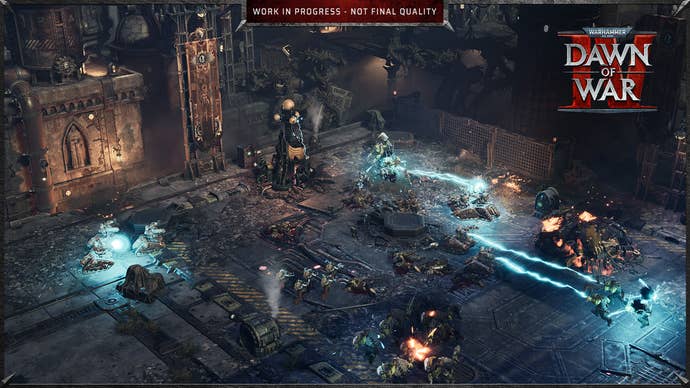
And down on the ground that combat, when it gets going is a delight. DoW 4’s guns sound absolutely sensational, a full roster of every noise you ever made with your mouth while running around the playground aged 11. Brrrrrr, Pfffff, Dug-dug-dug-dug– alright I’ll stop now. The guns go boom, it’s fun. Beyond that there’s some more refined stuff to it, don’t worry: a lovely dovetailing between micromanagement at the infantry level – upgrading weapons, turning on auto-reinforce, firing a grenade, using one of your Dreadnought’s two fantastic ranged abilities, spectacular little missile arrays, before toggling them to melee mode and getting them in close. Zooming in to move units into bits of cover (which feels quite DoW 2) or to watch that fancy new animation feature, the “combat director” which is essentially a fully choreographed system whereby all melee animations are synched, and then pulling right out to think big picture again and reposition.
That combat director, by the way, is incredibly promising. It remains to be seen just how “sticky” your units are, which is the key concern. This build is actually a very early one – while most of the environments were gorgeous in their gothic misery, the Space Marine’s base buildings were all still placeholder assets; it’s that early – and this is the one point where things were a tad rough around the edges. It was hard to know when a unit was locked in combat for a bit too long, and when things were just generally chugging a little. But as pure visual spectacle: wow. I can’t think of another RTS that’s done anything like it. If KING Art pulls it off – and it’s still an if for now – I’m not sure I’ll be able to look at those others in the same way again.
There’s even more nuance here to the combat, if you look extra close. The Space Marines, for instance actually have three colour-coded bars to keep in mind for each unit. The standard health bar is one, XP another, and then a curious third, which fills up and then depletes. This is a kind of temporary bonus health, granted from losing squadmates and likewise killing foes – a form of zealous combat fervour that encourages you to play them aggressively, to stick out combat knowing that if you can just keep them alive long enough, they’ll gain enough momentum to turn the tide. All this, coupled with just fantastically satisfying end-game units – Terminators and then some – made them feel incredibly powerful. I suspect the others will do too when manned by human players or on a higher difficulty – the Orks had vast numbers here, it’s just the AI never actually gathered them all in one place and attacked, instead lurking in that classic RTS-story-mission-wait-for-the-narrative-trigger way; if they had clumped up as one I’d have likely been completely overrun from the off.
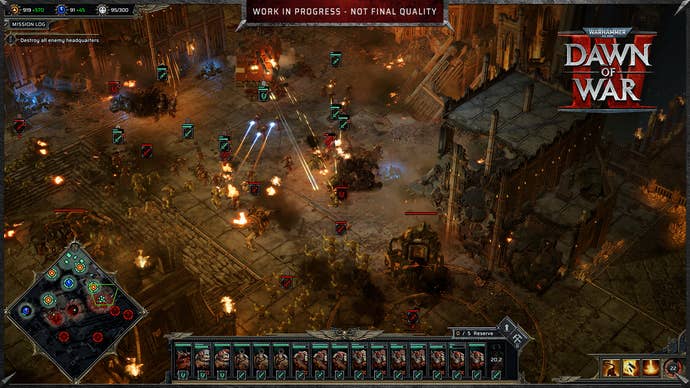
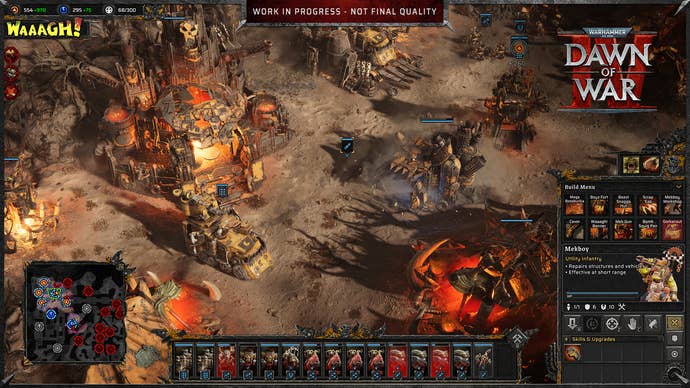
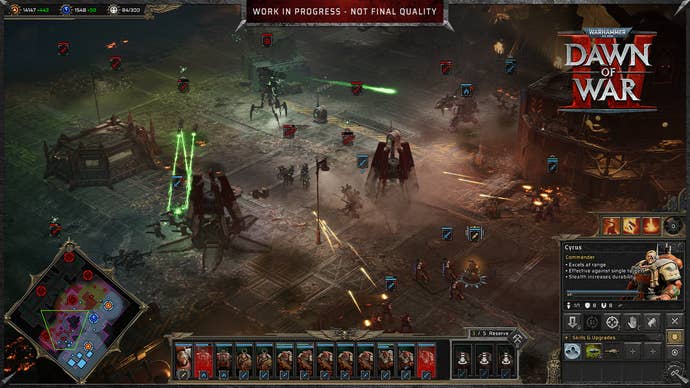
The golden thread running through all of this, meanwhile, is spectacle. Dawn of War 4 is an absolute feast of elaborate animations, weapon effects and sounds. The army scales can be huge, base buildings are comically large, turrets are meaty as anything. The Necrons zap and prang with ominous terror, the Ad-Mechs clunk onwards with lavish, metallic menace, the Orks move in a swarm like a single-bodied ocean. The Space Marines feel like a genuine enactment of a brutal purge, and all this amongst grim architecture and squelching gore. This is just as 40K as any game has felt to me, across genres, at least in a single mission, and it’s absolute magic.
If there’s one thing missing here, in this thin slice, it’s the bit of campiness present in the original. Saying that might be heresy to some, but I’d challenge those people to go back and study the source material a little closer. Campiness is inherent to Warhammer, even 40K, and such emphasis has been placed on the grimness and the darkness in recent years that it’s often easy to forget that something that actively defines itself as “grimdark” is kind of inherently silly, at least in some form.
If there’s something I’m really craving here it’s a bit of the original’s ludicrous, scenery-chewing line delivery that made it so perpetually quotable. But hey, Gorgutz is in it. And Gretchins. There’s still hope! And hope is ultimately the big take-away for me here. After so many false starts over the years, not even just for Dawn of War but for the genre as a whole, I feel sincerely good about this one. Dawn of War is back; it’s just got to stick the big, meaty squelch of its upcoming landing.







.jpg?width=1200&height=630&fit=crop&enable=upscale&auto=webp&w=100&resize=100,100&ssl=1)